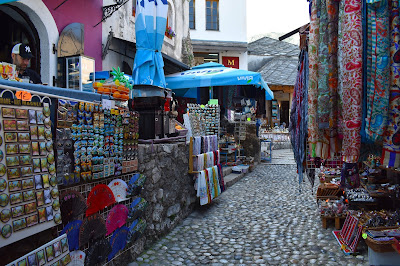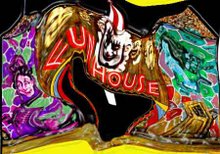Mostar Bosnia and Herzogovina
So we were back on the road again, this time headed for Croatia via Bosnia and Herzoginia.
Once again the scenery was nothing to complain about and it seemed to get lusher as we went northward.
The border crossings were often not the most pleasant experience and the officials often
Still even the waits in hot temperatures outside the bus were surrounded by gorgeous, unspoiled landscapes.
Since we were driving up the coast there were lots of water features.
We also passed lots of fruit stands, all ordered and organized in a very structured and efficient fashion.
Water and mountains, what more could you really want in life?
Occasional buildings with clay tile rooves dotted the fields between woods and mountains.
Twice we went through Medugorje in Herzogovina where six children believe that the Virgin Mary has appeared to them. Each year some 1 million pilgrims visit the site and report a variety of spiritual phenomena.
Outside the village is a marker you can see from the highway, but the actual site is removed from the road.
Sheep and cows still dot the hillsides and fields.
And of course there are villages and towns interspersed along the highway.
And there are always mountains in the background.
We arrived in Mostar, in the evening and had the opportunity to go on a night walk through the town. The building below was pointed out to us as an Austro-Hungarianian style building. It was the International High School.
Not everything has been restored. There are desserted buildings sprinkled throughout the area - a grim reminder of the war.
Our breakfast at the hotel was as nicely ordered as the wares of the roadside sellers.
In the morning we walked around in the daylight. Here is the Gimnazija Mostar above, but in the sunshine.
In the daylight the evidence of the wars is also more visible.
Our guide met with us before a church with an extremely high tower.
I caught a glimpse of a lizard while we were doing our walking tour.
Architecture was a mixture of old and new and remembrances of the war.
Mostar is a city named for this major landmark. In slavic languages star(r) means old and Most means bridge. When you walk through the market eventually you come to the Stari Most (old bridge) from which the town gets its name.
The view from the bridge is lovely.
The bridge was constructed in the 16th century by Mimar Hayruddin an apprentice to Mimar Sinan who built some of the most well known buildings in Istanbul.

It stood for 427 years before being destroyed in the war on November ninth 1993.
The bridge was rebuilt in 2004 using some of the old materials.
This is the shopping zone nearby.
This is a Muslim cemetery where the Imams are buried.
We visited a museum mosque.
Although representational work is mostly forbidden in Islamic art, the geometric designs bear a resemblance to some nature motifs.
The interior is fairly light because of the many windows.
I bought a silk scarf here, mostly as a way to remember my visit to Mostar.
There were not as many tourists here, so we had a pleasant walk around the inner part of the town.
In front of the church with the tall tower there was this commemoration.
I tend to focus on the older cultural icons, but it is important to remember that we are always visitng modern cities with their share of contemporary structures and urban issues.
The streets had a lot of graffiti and of course there were the ever-present billboards.
After our tour, it was back to the bus and onwrd with our travels and we said good bye to Mostar.
We passed cemeteries...
...and fortresses
and even a couple of national parks.
Our path was ever northward.
We stopped at a rest stop that bordered on the famous water falls (Maybe Kravica?).
I had the opportunity to enjoy some wild flowers there, like these poppies.
The farther north we got, the more it looked like the Europe that I was familiar with in Austria and Germany.
This was an interesting mountain formation.
This was an ad for the Krapina Neanderthal museum in Croatia. It is advertised as the most modern museum in Europe -which seems funny given the subject matter!















































No comments:
Post a Comment